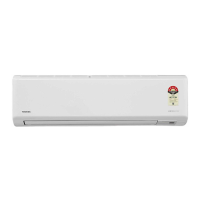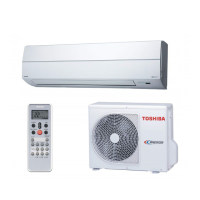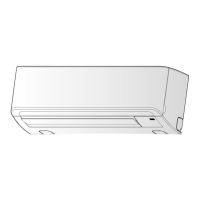
Do you have a question about the Toshiba RAS-22N3KV2-A and is the answer not in the manual?
| Cooling Capacity | 2.2 kW |
|---|---|
| Heating Capacity | 2.5 kW |
| Energy Efficiency Ratio (EER) | 3.21 |
| Coefficient of Performance (COP) | 3.61 |
| Power Supply | 220-240V, 50Hz |
| Refrigerant | R410A |
| Indoor Unit Weight | 9 kg |
| Noise Level (Outdoor) | 50 dB(A) |
| Type | Split System |
Displays operational current vs. compressor speed for cooling and heating.
Shows how cooling/heating capacity changes with outdoor temperature.
Essential precautions for handling R410A refrigerant during installation and servicing.
Guidelines for selecting and installing pipes and joints suitable for R410A.
Lists required and general tools for R410A system installation and servicing.
Step-by-step procedure for correctly recharging refrigerant into the system.
Details on materials, flux, and methods for brazing refrigerant pipes.
Exploded view and dimensions of the indoor unit components.
Exploded view and dimensions of the outdoor unit components.
Comprehensive wiring diagram showing connections between indoor and outdoor units.
Lists types and specifications for indoor unit electrical components.
Lists types and specifications for outdoor unit electrical components.
Visual representation of the refrigerant flow and key components in the system.
Performance data under specific cooling and heating conditions.
Diagram illustrating the control logic and components of the indoor unit.
Diagram illustrating the control logic and components of the outdoor unit.
Overview of the capacity-variable system and control hierarchy.
Detailed explanation of various operating modes and functions.
How to set, cancel, or manage the auto restart feature after power failure.
Explains functions and operation of the remote controller.
Visual guide showing placement and connection points for units.
Covers optional parts, accessories, tools, and general installation steps.
Detailed procedures for installing the indoor unit, including mounting and wiring.
Procedures and precautions for installing the outdoor unit, including site selection.
Covers gas leak testing, remote control setup, and test operations.
Initial checks for power supply and voltage before troubleshooting.
Methods for initial troubleshooting, including LED indicators.
Interpreting LED error codes for diagnosing indoor unit issues.
Using the remote controller to perform self-diagnosis and read error codes.
Troubleshooting based on observed symptoms and unit behavior.
Step-by-step guide to diagnosing issues specific to the outdoor unit.
Procedures for checking key components like P.C. boards and sensors.
Method to test the outdoor fan motor's functionality and condition.
Procedures for replacing components of the indoor unit.
Procedures for replacing components of the outdoor unit.
Visual breakdown and part numbers for the indoor unit.
Specific exploded view and parts list for certain indoor unit components.
Visual breakdown and part numbers for the outdoor unit.
Specific exploded view and parts list for certain outdoor unit components.











